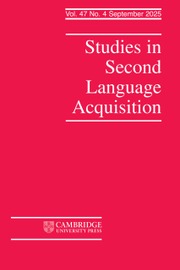Crossref Citations
This article has been cited by the following publications. This list is generated based on data provided by
Crossref.
Salaberry, M.
1998.
On Input Processing, True Language Competence, and Pedagogical Bandwagons: A Reply to Sanz and VanPatten.
The Canadian Modern Language Review,
Vol. 54,
Issue. 2,
p.
274.
Ellis, Nick C.
and
Schmidt, Richard
1998.
Rules or Associations in the Acquisition of Morphology? The Frequency by Regularity Interaction in Human and PDP Learning of Morphosyntax.
Language and Cognitive Processes,
Vol. 13,
Issue. 2-3,
p.
307.
Krashen, Stephen D.
1999.
Seeking a Role for Grammar. A Review of Some Recent Studies.
Foreign Language Annals,
Vol. 32,
Issue. 2,
p.
245.
Salaberry, M.Rafael
2000.
The acquisition of English past tense in an instructional setting.
System,
Vol. 28,
Issue. 1,
p.
135.
Norris, John M.
and
Ortega, Lourdes
2001.
Does Type of Instruction Make a Difference? Substantive Findings From a Meta‐analytic Review.
Language Learning,
Vol. 51,
Issue. s1,
p.
157.
Ellis, Rod
2001.
Introduction: Investigating Form‐Focused Instruction.
Language Learning,
Vol. 51,
Issue. s1,
p.
1.
Leaver, Betty Lou
and
Shekhtman, Boris
2002.
Developing Professional-Level Language Proficiency.
EBSWORTH, MIRIAM EISENSTEIN
2002.
Comment.
International Journal of the Sociology of Language,
Vol. 2002,
Issue. 155-156,
Norris, John
and
Ortega, Lourdes
2003.
The Handbook of Second Language Acquisition.
p.
716.
Segalowitz, Norman
2003.
The Handbook of Second Language Acquisition.
p.
382.
Chaudron, Craig
2003.
The Handbook of Second Language Acquisition.
p.
762.
Robinson, Peter
2003.
The Handbook of Second Language Acquisition.
p.
631.
DeKeyser, Robert
2003.
The Handbook of Second Language Acquisition.
p.
312.
Toth, Paul D.
2004.
When Grammar Instruction Undermines Cohesion in L2 Spanish Classroom Discourse.
The Modern Language Journal,
Vol. 88,
Issue. 1,
p.
14.
Leaver, Betty Lou
Rifkin, Benjamin
and
Shekhtman, Boris
2004.
Apples and Oranges Are Both Fruit, But They Don't Taste the Same: A Response to Wynne Wong and Bill VanPatten.
Foreign Language Annals,
Vol. 37,
Issue. 1,
p.
125.
Rosa, Elena M.
and
Leow, Ronald P.
2004.
Computerized Task‐Based Exposure, Explicitness, Type of Feedback, and Spanish L2 Development.
The Modern Language Journal,
Vol. 88,
Issue. 2,
p.
192.
Bitan, T.
and
Karni, A.
2004.
Procedural and declarative knowledge of word recognition and letter decoding in reading an artificial script.
Cognitive Brain Research,
Vol. 19,
Issue. 3,
p.
229.
ROSA, ELENA M.
and
LEOW, RONALD P.
2004.
Awareness, different learning conditions, and second language development.
Applied Psycholinguistics,
Vol. 25,
Issue. 2,
p.
269.
Rifkin, Benjamin
2004.
A Response to Glisan and Donato.
Foreign Language Annals,
Vol. 37,
Issue. 3,
p.
477.
Hegelheimer, Volker
and
Tower, Dustin
2004.
Using CALL in the classroom: Analyzing student interactions in an authentic classroom.
System,
Vol. 32,
Issue. 2,
p.
185.

